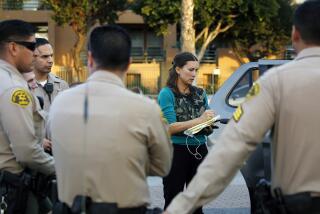Police Draw Censure Over Wilkening File
- Share via
A client list kept by convicted madam Karen Wilkening may have been tampered with while in San Diego police custody, the county grand jury said Wednesday in a report critical of department procedures in cases of possible “corrupt or criminal” police conduct.
The list--a Rolodex file kept by Wilkening, who ran a high-class call-girl ring--contained the name of at least one police officer and other “familiar” and “prominent” people, according to the grand jury.
The grand jury report did not name any of the names on the list but said that police work on the case was uneven and that one card that may have been in the Rolodex is there no longer. But it added that police did not “sanitize” the list to protect the names of high-profile customers.
The grand jury strongly criticized the chain of custody police used to maintain the Rolodex as potential evidence, saying the file was often simply left unattended on a desk. The report also said that officers botched the original search that produced the file and suggested that some officers may have lied to the panel while testifying under oath.
The panel recommended that the department make investigations involving possible police corruption or criminal conduct a “top priority of high command officers.” It also urged adherence to “the highest police standards” and suggested discipline for any officer who lies on duty.
However, the report also said that “important matters” on the case had to be referred to next year’s grand jury, since the current panel goes out of business at the end of the week, June 30. The report did not elaborate on those “important matters.”
J. Phil Franklin, the foreman of the current panel, said Wednesday that “there are so many things I’d like to say” about the case. But he said he felt compelled to decline comment since the case had been referred for further review to the new grand jury, which begins operation July 1.
The county district attorney’s office, Franklin said, advised him that his decision not to comment on the report was shrewd. But Franklin added that the D.A.’s office did not order him not to talk.
Police Chief Bob Burgreen did not answer a phone call Wednesday to his office seeking comment on the report. A department spokesman, Cmdr. Larry Gore, did not return a phone call Wednesday to his office.
Wilkening, now serving a 44-month prison sentence, has been quoted as saying that information in the Rolodex could “ruin people’s reputations and lives.”
She was sentenced in November after pleading guilty to two felony counts in connection with what prosecutors said was a high-class call-girl ring run out of a Linda Vista condominium.
Wilkening fled to the Philippines in September, 1987, while facing a preliminary hearing in the case. At a cost of $20,000, she was brought back to the United States in May, 1989, by police officers who hoped she might be able to provide authorities with leads in the killings of 40 prostitutes and other women. She apparently was unable to help in that case.
Reports of the Rolodex surfaced during hearings in her case. The grand jury said Wednesday that the file was discovered May 19, 1987, when San Diego police searched Wilkening’s home.
As many as 14 officers, all under the supervision of an unnamed vice-unit lieutenant, took part in the search, which was executed under a warrant, the report said.
During the search, several officers observed at least 15 to 20 business cards in plain sight but no one seized them, the grand jury said. This was a “serious mistake,” because all the officers should have known the cards might have become relevant evidence, the report said.
The Rolodex, which included the name of the one police officer, was seized during the search. Curious about its contents, several officers looked at it, according to the grand jury.
The vice lieutenant, meanwhile, “wanted to know if there were any names of well-known citizens in the Rolodex because he was always concerned about newsworthy matters or matters that would be ‘embarrassing’ to the Police Department,” the grand jury said.
The file was taken to police headquarters, where indications are that it sat unattended on another officer’s desk, the report said.
During the one or two weeks it took to type a “complete” list of names on the Rolodex, that officer took it to various lieutenants, captains and commanders, who took custody of it.
It was “unusual” for those intermediate-level officers to take physical possession of that kind of potential evidence, the report said. If they “were really concerned about integrity rather than preventing departmental embarrassments, a better chain of custody should have been maintained,” it said.
Many of the officers who testified before the grand jury were credible, but “several” gave “incredible” testimony, which “outraged” the panel, the report said. It was “particularly frustrating to hear the failure of intermediate command officers in recalling or recounting their handling of physical evidence in seemingly unforgettable circumstances.”
The department’s “complete” typed list of names in the Rolodex, meanwhile, was incomplete, the report said. However, it said that the omissions do not appear significant and probably were the result of carelessness.
The grand jury said it concluded that only the one police officer’s name was and still is listed in the Rolodex.
But, it said, the case is “disturbing” because “credible evidence” indicates that a single card that may have been in the Rolodex is not there any longer.
The name on that card would have “caught the attention of any experienced police officer, even though it was not the name of a past or present police officer,” it said.
The report said it was “possible that someone placed the card in the Rolodex as a joke and then removed it.” But, it said it also was possible that the card was originally in the Rolodex and removed by a police officer “seeking to protect someone because of a similarity of names.”
“This is ironic,” the report said, since anyone who knew the identity of the person on the card would know that the person “had nothing to do with the Police Department and removing it did nothing to ‘protect’ the police.”
The Rolodex was delivered in July, 1987, to a deputy district attorney preparing for Wilkening’s preliminary hearing. When Wilkening fled, the D.A.’s office put together a separate file on the case that contained a summary of the charges but no details of the customer list.
Later, a lawyer who was a customer of Wilkening’s learned from a district attorney’s investigator that the file in Wilkening’s case had been “sanitized” to remove all customer names. This was a reference to the new file, the grand jury reported.
However, the lawyer inferred that the Rolodex had been purged and, seeking to avoid being called as a witness in Wilkening’s case, reported that theory to the D.A.’s office, according to the report.
In June 1989, the matter was turned over to the grand jury--to the panel that preceded the current one. About the same time, a news story used the word “sanitized,” the report said.
The word “sanitized” had been used only in an official internal memorandum at the D.A.’s office and referred to the new file that had been prepared on the case, the grand jury said.
More to Read
Sign up for Essential California
The most important California stories and recommendations in your inbox every morning.
You may occasionally receive promotional content from the Los Angeles Times.










